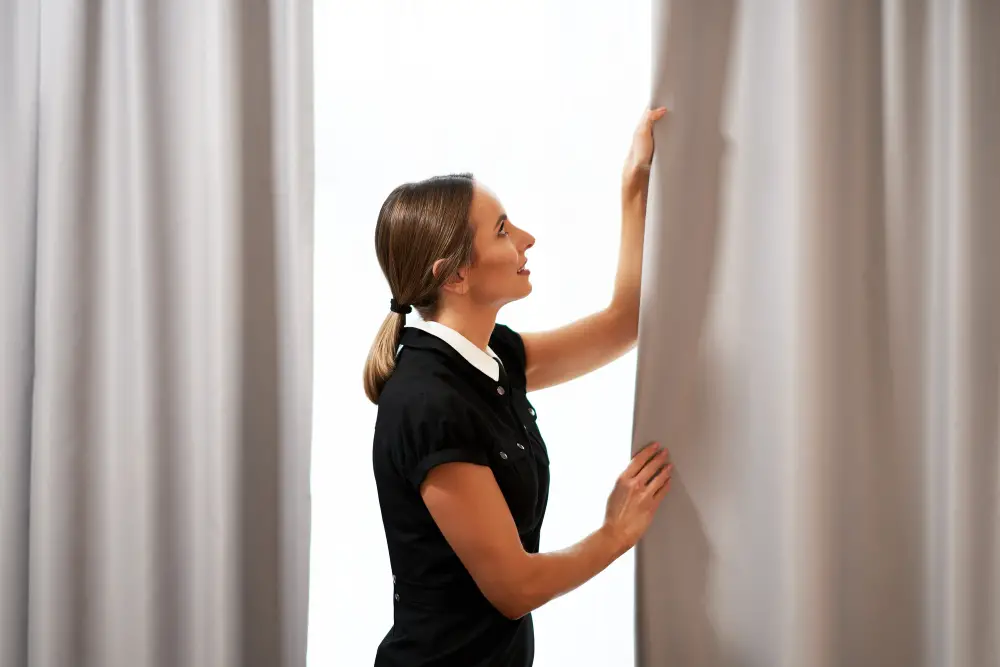Explore the art of mastering curtain clips to enhance your window treatment aesthetics with this comprehensive guide.
Curtain clips can be a game-changer when it comes to hanging your drapes with ease and style. These handy little tools not only secure your curtains but also add a touch of elegance to your window treatments.
To use curtain clips, begin by attaching them to your curtains at equal intervals, usually about 4 to 6 inches apart. Then, simply slide the clips onto your curtain rod.
Be assured that this article will guide you through the process, whether you’re working with pinch-pleat drapes or eyelet curtains, providing all the details you need to make the job a breeze.
Key takeaways:
- Use curtain clips to hang curtains with ease and style
- Determine the type of drapes suitable for clips (e.g. pleated drapes, grommet curtains)
- Calculate the number of curtain rings per panel based on width and desired look
- Follow a step-by-step process to attach curtain clips to your curtains
- Explore ways to hide curtain clips for a clean and streamlined look
Supplies Needed for Using Curtain Clips

To ensure a smooth setup, keep these essentials at hand: curtain clips, also known as curtain ring clips; a measuring tape for accurate curtain and window measurements; a level to enable straight mounting of your curtain rod; a pencil for marking drill holes; a screwdriver or a power drill for secure installation; a step ladder for reaching heights; and of course, your chosen curtains, fabric, or drapes. These items will ensure a straightforward process, minimizing potential interruptions.
Determining the Type of Drapes Suitable for Clips

Fabrics with medium to heavy weight like velvet, brocade, or denim lend themselves well to clips as they provide sufficient balance, preventing the clips from sliding. Lighter fabrics such as silk or lace may require additional clips for secure attachment, or can sometimes be better suited for rod-pocket installations.
Types of drapes that work well with clips include pleated drapes, grommet curtains, and tab top curtains.
Flat panel curtains without pre-existing holes or loops can also be hung using clips. This even allows for height adjustments, a perk not commonly associated with traditional installation methods.
Keep in mind the style of your room, as clips tend to add a casual, rustic visual element to your decor. However, for a more traditional or formal setting, you might opt for hidden clips or a different hanging method altogether. Always ensure the clips match or complement your curtain rods and overall aesthetic.
Remember that the top of your curtain needs to be sturdy and well-structured for clips to hold. Flimsy fabrics or those without a firm top may sag or droop when clipped.
How Many Curtain Rings Per Panel?

To calculate the necessary quantity, first, measure the width of your curtain panel. A common rule of thumb is to use approximately one ring for every 4-6 inches. However, this can marginally change based on how full you want your curtains to look or the design of the fabric.
Consider the style of draping you desire. Scattered clips work for less formal looks, while evenly spaced clips add precision to more formal drapery.
For a flowing look, calculate ring requirements based on the stretched width. In contrast, for a fuller look, calculate the capacity based on the bunching width.
Putting one ring at each panel end ensures curtains stay well-hung across the curtain rod. Therefore, an additional ring at the end points is worth considering.
In case of heavier fabrics, placing rings closer together helps distribute weight evenly and helps maintain the drape’s shape.
Always test out your arrangement before committing to it to ensure your satisfaction with how the curtains hang.
Determining How Many Curtain Hooks to Use

To estimate the number of curtain hooks required, you’ll need to consider three things:
1. Curtain width: First, double the width of your window. If your window is 60 inches wide, you’ll need a 120-inch-wide curtain.
2. Ring spacing: Spacing ring clips about every 4 inches usually results in a nice gather. For a 120-inch curtain, you would divide that by 4, which gives you 30.
3. Corner hooks: Don’t forget about the corners. Add one extra clip on each end. In total, for a 120-inch curtain, you’ll need 32 clips.
Remember, curtain clips should be evenly dispersed across the top of the curtain to maintain an evenly pleated look. Measure and mark where each clip will go before starting to ensure accuracy.
Step-by-Step Process of Using Curtain Clips

Begin by extending the clips on the rings. For this, you simply open the clip and slide the ring onto the rod. Keep in mind that the clips should face toward the back, not the front.
Next, take the top edge of your curtain and fold it back. Attach the curtain clip to the fold to secure it in place. Repeat this step, spacing the clips evenly across the width of the curtain.
If your panels have a rod pocket, consider leaving it as it is, and attach the clips above it for a ruffled effect. This also allows for additional length.
Depending on your preference, you can use the clips to create a pleated look. Fold your curtains into pleats before attaching each clip.
Remember to keep the spacing of the clips as even as possible for the best aesthetic results. Maintaining an equal distance will not only ensure the stability of your curtains but will also provide a uniform, pleasing appearance.
Once all the clips are in place, carefully slide the rings along the rod to position your curtain as desired. Enjoy your beautifully hung curtains!
How to Hide the Clip Rings and Maintain Aesthetics

For those seeking a clean and streamlined look, hiding curtain clips may be desirable. Here are some tips to maintaining aesthetics while using curtain clips:
Choose a curtain rod that matches the color of your clip rings. A consistent color palette makes the clips less noticeable.
Consider the back-tab method. Feed the clip through the back-tab of the curtain, this keeps them on the reverse side, hidden from view.
Opt for decorative rings with clips. Not all curtain clips must be hidden. Decorative rings add an element of style while still serving a purpose.
Choose curtains with a built-in channel at the top. You can run the clip through this channel, leaving the majority of the clip, including the ring, hidden behind the curtain.
Use double rods. Hang the curtain on the back rod and the valance on the front one – this conceals the clip rings.
Just remember, the decorative element of curtain clips is not universally undesirable. Many stylish drapes showcase their curtain clips as part of the overall design appeal. It’s a matter of personal preference.
Maintain Curtain Shape By Training Your Curtains

Begin by evenly spacing the curtain clips and hanging your drapes. Make sure they stay smooth and level. Next, establish the folds for your drapes by manually creating even “pleats.” Gently pinch the fabric at the top, near the curtain clip, then let the material fall naturally. Repeat this process for every curtain clip.
Next, tie a soft, flexible material like ribbon or twine loosely around the drapes, ensuring each is still in alignment. This doesn’t need to be tight; you’re just aiming to gently encourage the curtain fabric to remain in its pleated position.
Keeping the tiebacks in for a few days is a practical and low-effort way to coax your curtains into their ideal shape. If the pleats start to relax or come undone after removing the tiebacks, simply repeat the process until the fabric retains the desired shape.
Remember, fabrics often take several days to naturally ‘memorize’ the shape. This method, known as “training your curtains,” will ensure that your drapes maintain their beautiful, full-bodied appearance. Follow these steps, and your curtains are sure to be the envy of any guest.
Selecting the Right Size of Curtain Clips

Selecting clips of the appropriate size can be critical for the overall functionality and aesthetics of your curtains.
Various sizes in curtain clips are available ranging from small, medium to large. The size to opt for essentially depends on two key factors: the weight of your curtains and the size of your curtain rod.
A heavyweight curtain requires larger clips to hold the fabric properly. On the other hand, a lightweight fabric can be easily held up even with small clips.
Regarding the curtain rod size, more giant clips also mean larger ring holes, which would easily move across bigger rods ensuring smooth operation.
Keep in mind the aesthetic factor as well. Smaller clips might look neater on sheer, lightweight drapes as they are less noticeable.
Always remember to test a clip before purchasing in bulk. Some curtain and fabric stores may allow you to bring a swatch of your curtain fabric to test with different clip sizes. This can help ensure you find the best fit before committing to a purchase.
FAQ
How do curtain rail clips work?
Curtain rail clips work by being attached to the top edge of the drapery panel, allowing the attached rings to slide over the rod, thus hanging the drapery panel.
What are the different materials used for curtain rail clips?
Curtain rail clips are commonly made from materials such as metal, plastic, and wood.
How do you install curtain rail clips correctly?
To install curtain rail clips correctly, you need to measure and mark the desired positions on the rail, then affix the clips using the provided screws, ensuring they are evenly spaced to support the weight of the curtain evenly.
Are curtain rail clips suitable for all types of curtains?
Curtain rail clips are not suitable for all types of curtains as heavy ones might require more support like curtain rods or tracks.
Recap





